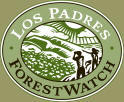|

The federal
Endangered Species Act protects more than 1,200 different plant
and animal species that are on the brink of extinction. The
Los Padres provides habitat for 26 of these protected species, more than any
other national forest in California.
Species classified as endangered
(E) are in danger of extinction, and species classified as
threatened (T) is likely to become endangered within the
foreseeable future. Candidate (C) species have declined to such
a level that they qualify for endangered or threatened status,
but the federal agency in charge of officially adding them to
the list has not yet done so.

In addition to the
federally-protected plants and animals listed above, the
Los Padres National Forest is also home to an additional 92 "sensitive"
species. The population viability of these species is a concern due to
current or predicted downward trends in population numbers or
habitat capability. Whenever the Forest Service undertakes
or approves an activity on public lands, officials are required
by law to avoid or minimize impacts to these sensitive species.
The
"sensitive species" found
in the Los Padres National Forest are:
BIRDS
Bald eagle
Northern goshawk
California spotted owl
Swainson's hawk
Willow flycatcher
Peregrine falcon
MAMMALS
Mt. Pinos lodgepole chipmunk
Tehachapi white-eared pocket mouse
Townsend's big-eared bat
Pallid bat
Western red bat
REPTILES &
AMPHIBIANS
Southern Pacific pond turtle
San Diego horned lizard
California legless lizard
Southern rubber boa
Two-striped garter snake
Foothill yellow-legged frog
Yellow-blotched salamander
Tehachapi slender salamander
FISH
Santa Ana sucker
Santa Ana speckled dace
|
PLANTS
Arroyo de
la Cruz manzanita
Bishop manzanita
Hoover’s manzanita
Little Sur manzanita
Santa Lucia manzanita
Santa Margarita manzanita
Refugio manzanita
San Luis mariposa lily
San Luis Obispo mariposa lily
Palmer’s mariposa lily
Plummer’s mariposa lily
Weed’s mariposa lily
Dwarf western rosinweed
San Luis Obispo sedge
Santa
Barbara jewelflower
Blakeley’s spineflower
San Luis Obispo spineflower
Prickly spineflower
San Fernando Valley spineflower
Long spined spineflower
Monterey larkspur
Mt. Pinos larkspur
Umbrella larkspur
Hoover’s eriastrum
Yellow woollystar
Butterworth’s buckwheat
Southern alpine buckwheat
Fort Tejon woolly sunflower
Talus fritillary
Ojai fritillary
San Benito fritillary
Fragrant fritillary
Cone Peak bedstraw
Hardham’s bedstraw
Santa Lucia bedstraw
Pale-yellow layia
Jones’s layia
San Luis Obispo lupine
Carmel Valley malacothrix
Flax-like monardella
Palmer’s monardella
Baja pincushionplant
Rock Creek broomrape
Dudley’s lousewort
Meager pygmydaisy
Hooked popcornflower
Nuttall’s scrub oak
Adobe sanicle
Cuesta Pass checkerbloom
Hickman’s checkerbloom
Parish’s checkerbloom
Southern jewelflower
Santa Ynez false lupine
Santa Lucia fir
Abrams’ oxytheca
Hoover’s bentgrass
Hickman’s onion
Mt. Pinos onion
Smooth baccharis
Dwarf goldenstar
Cambria morning glory
Hardham’s evening-primrose
Muir’s tarplant
Mojave Indian paintbrush
Lemmon’s wild cabbage
Dwarf soaproot
Jolon clarkia
San Gabriel alumroot
Urnflower alumroot
Coast horkelia
Wedgeleaf horkelia
Pumice alpinegold
California satintail
Southern honeysuckle
Carmel Valley bush mallow
Arroyo Seco bush mallow
Santa Lucia bush mallow
Peninsular beargrass
Transverse Range phacelia
Chickweed starry puncturebract
Most beautiful jewelflower
San Bernardino aster
Sonoran maiden fern
Cook’s triteleia
Caperfruit tropidocarpum
Goosefoot yellow violet
Santa Lucia horkelia
|

California black
bear
Coast redwood
Pronghorn antelope
Tule elk Management
Indicator Species
Management Indicator Species ("MIS") are plants and animals
that are monitored by the U.S. Forest Service because they
indicate the effects of land use activities on the Los Padres
National Forest. When monitoring indicates that their
populations are declining, the Forest Service knows to make
adjustments to how it manages the area. The Los Padres National
Forest contains twelve MIS, including:
Mountain lion
Mule deer
Arroyo toad
Song sparrow
Blue oak
Engelmann oak
Valley oak
Bigcone Douglas-fir
Coulter pine
California spotted
owl
California black oak
White fir
High Priority Migratory Bird
Species
California Bird Species of
Special Concern
California Fully Protected
Species
The State of
California has classified certain wildlife species as "Fully
Protected," which means that they may not be killed or "taken"
at any time. The classification of Fully Protected was the
State's initial effort in the 1960s to identify and provide
additional protection to those animals that were rare or faced
possible extinction.
Unarmored threespine stickleback
Blunt-nosed leopard lizard
American peregrine falcon
California brown pelican
California
condor
California least tern
Golden eagle
Greater sandhill crane
Southern bald eagle
White-tailed kite
Bighorn sheep
Ring-tailed cat
Southern sea otter
Northern elephant seal
|

